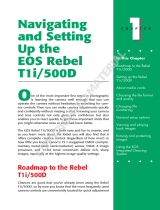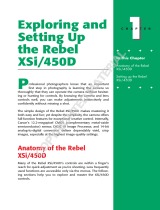Page is loading ...

EF-S18-135mm f/3.5-5.6 IS
Instruction
ENG
COPY

ENG-1
Thank you for purchasing a Canon product.
The Canon EF-S18-135mm f/3.5-5.6 IS lens is
a high-performance high-magnification zoom
lens equipped with an Image Stabilizer, and
has been developed for digital SLRs
compatible with EF-S lenses*.
¡“IS” stands for Image Stabilizer.
Features
1. The Image Stabilizer gives the equivalent
effect of a shutter speed four stops faster*.
This function provides optimal image
stabilization depending on shooting conditions
(such as shooting still subjects and following
shots).
2. Aspherical and UD lens elements result in
outstanding image delineation.
3. A truly round aperture hole results in a nicer
background blur.
* Based on [1/(focal length x 1.6)] second. Generally,
it requires a shutter speed [1/focal length] second or
faster to prevent camera shake (in 35mm format.
With an EF-S lens, it would be [1/(focal length x
1.6)] second).
Conventions used in this instruction
Warning to prevent lens or camera
malfunction or damage.
Supplementary notes on using the lens
and taking pictures.
* Only the following cameras are compatible with
EF-S lenses (as of August 2012):
EOS 7D, EOS 60D, EOS 50D, EOS 40D, EOS
30D, EOS 20D, EOS 20Da, EOS REBEL
T4i/650D, EOS REBEL T3i/600D, EOS REBEL
T2i/550D, EOS REBEL T1i/500D, EOS REBEL
XSi/450D, EOS REBEL T3/1100D, EOS REBEL
XS/1000D, EOS DIGITAL REBEL XTi/400D
DIGITAL, EOS DIGITAL REBEL XT/350D
DIGITAL, EOS DIGITAL REBEL/300D DIGITAL
COPY

ENG-2
a Safety Precautions
• Do not look at the sun or a bright light source
through the lens or camera. Doing so could
result in loss of vision. Looking at the sun directly
through the lens is especially hazardous.
• Whether it is attached to the camera or not, do
not leave the lens under the sun without the
lens cap attached. This is to prevent the lens from
concentrating the sun’s rays, which could cause a
fire.
Handling Cautions
• If the lens is taken from a cold environment into
a warm one, condensation may develop on the
lens surface and internal parts. To prevent
condensation in this case, first put the lens into an
airtight plastic bag before taking it from a cold to
warm environment. Then take out the lens after it
has warmed gradually. Do the same when taking
the lens from a warm environment into a cold one.
• Do not leave the lens in excessive heat such as in
a car in direct sunlight. High temperatures can
cause the lens to malfunction.
This device complies with Part 15 of the FCC Rules. Operation is
subject to the following two conditions: (1) This device may not
cause harmful interference, and (2) this device must accept any
interference received, including interference that may cause
undesired operation.
Do not make any changes or modifications to the equipment
unless otherwise specified in the instructions. If such changes or
modifications should be made, you could be required to stop
operation of the equipment.
This equipment has been tested and found to comply with the
limits for a class B digital device, pursuant to part 15 of the FCC
Rules. These limits are designed to provide reasonable protection
against harmful interference in a residential installation. This
equipment generates, uses and can radiate radio frequency
energy and, if not installed and used in accordance with the
instructions, may cause harmful interference to radio
communications.
However, there is no guarantee that interference will not occur in
a particular installation. If this equipment does cause harmful
interference to radio or television reception, which can be
determined by turning the equipment off and on, the user is
encouraged to try to correct the interference by one or more of
the following measures:
• Reorient or relocate the receiving antenna.
• Increase the separation between the equipment and receiver.
• Consult the dealer or an experienced radio/TV technician for
help.
This Class B digital apparatus complies with Canadian ICES-003.
COPY

ENG-3
Nomenclature
Contacts
(→ 4)
Focus mode switch (→ 4)
Image stabilizer switch (→ 6)
Hood mount (→ 5)
Lens mount index (→ 4)
Filter mounting
thread (→ 8)
Zoom ring (→ 5)
Focusing ring (→ 4)
Zoom position index (→ 5)
For detailed information, reference page numbers are provided in parentheses (→ **).
COPY

ENG-4
1
Mounting and Detaching the Lens
See your camera’s instructions for details on
mounting and detaching the lens.
¡After detaching the lens, place the lens with the
rear end up to prevent the lens surface and
electrical contacts from getting scratched.
¡If the contacts get soiled, scratched, or have
fingerprints on them, corrosion or faulty
connections can result. The camera and lens
may not operate properly.
¡If the contacts get soiled or have fingerprints on
them, clean them with a soft cloth.
¡If you remove the lens, cover it with the dust
cap. To attach it properly, align the lens mount
index and the ¢ index of the dust cap as shown
in the diagram, and turn clockwise. To remove
it, reverse the order.
2
Setting the Focus Mode
To shoot in autofocus (AF) mode, set the focus
mode switch to AF.
To use only manual focusing (MF), set the focus
mode switch to MF, and focus by turning the
focusing ring.
¡Do not touch the rotating parts of the lens while
autofocus is active.
¡Do not adjust focus manually when the focus
mode switch is set to AF.
COPY

ENG-5
3
Hood (Sold Separately)
To zoom, turn the lens’ zoom ring.
The minimum focusing distance differs at
different focal lengths.
18mm: 0.49 m / 1.6 ft.
50mm: 0.47 m / 1.5 ft.
135mm: 0.45 m / 1.5 ft.
Shooting magnification
18mm: 0.05×
50mm: 0.12×
135mm: 0.21×
Be sure to finish zooming before focusing.
Changing the zoom ring after focusing can affect
the focus.
4
Zooming
The EW-73B hood can keep unwanted light out
of the lens, and also protects the lens from rain,
snow, and dust.
To attach the hood, align the hood’s attachment
position mark with the red dot on the front of the
lens, then turn the hood as shown by the arrow
until the lens' red dot is aligned with the hood's
stop position mark.
The hood can be reverse-mounted on the lens
for storage.
¡Part of the picture may be blocked if the hood is
not attached properly.
¡When attaching or detaching the hood, grasp
the base of the hood to turn it. To prevent
deformation, do not grasp the rim of the hood to
turn it.
COPY

ENG-6
5
Image Stabilizer
You can use the image stabilizer in AF or MF
mode.
This function provides optimal image stabilization
depending on shooting conditions (such as
shooting still subjects and following shots).
1
Set the STABILIZER switch to .
¡If you are not going to use the image
stabilizer function, set the switch to .
2
When you press the shutter button
halfway, the Image Stabilizer will
start operating.
¡Make sure the image in the viewfinder is
stable, then press the shutter button the
rest of the way down to take the picture.
¡The Image Stabilizer cannot compensate for a
blurred shot caused by a subject that moved.
¡The Image Stabilizer may not be fully effective if
you shoot from a violently shaking vehicle or
other transportation.
¡The Image Stabilizer consumes more power
than normal shooting, so fewer shots can be
taken if you use the function.
¡When shooting a still subject, it compensates for
camera shake in all directions.
¡It compensates for vertical camera shake during
following shots in a horizontal direction, and
compensates for horizontal camera shake
during following shots in a vertical direction.
¡Using a tripod also stabilizes the image.
However, depending on the kind of tripod and
shooting conditions, sometimes it may be better
to turn off the Image Stabilizer function.
¡The stabilizer is equally effective for hand-held
photography and photography with a monopod.
¡
The image stabilizer function also operates when the
lens is used with an Extension Tube EF12 ll or EF25 ll.
¡
If you set the camera’s Custom Function to change the
assigned button to operate the AF, the Image Stabilizer will
operate when you press the newly assigned AF button.
COPY

ENG-7
Image Stabilizer
The image stabilizer in this lens is effective for hand-held shots under the following
conditions.
¡In semi-darkened areas such as indoors or
outdoors at night.
¡In locations where flash photography is
prohibited, such as art museums and theater
stages.
¡In situations where your footing is uncertain.
¡In situations where fast shutter settings cannot
be used.
¡When panning subjects in motion.
COPY

ENG-8
6
Filters (Sold Separately)
You can attach filters to the filter mounting
thread on the front of the lens.
¡Only one filter may be attached.
¡If you need a polarizing filter, use the Canon
Circular Polarizing Filter PL-C B (67mm).
¡To adjust the polarizing filter, first remove the
lens hood.
7
Extension Tubes (Sold Separately)
You can attach Extension Tube EF12 II or EF25
II for magnified shots. The shooting distance and
magnification are shown below.
Camera-to-Subject
Magnification
Distance (mm)
Near Far Near Far
EF12 II
18mm Incompatible
135mm 304 1551 0.38× 0.09×
EF25 II
18mm Incompatible
135mm 252 806 0.59× 0.21×
Manual focusing is recommended for accurate
focusing.
COPY

ENG-9
8
Specifications
Focal Length/Aperture 18 – 135 mm f/3.5 – 5.6
Lens Construction 12 groups, 16 elements
Minimum Aperture f/22 – 36*
1
Angle of View Diagonal: 74° 20’ – 11° 30’ Vertical: 45° 30’ – 6° 20’
Horizontal: 64° 30’ – 9° 30’
Min. Focusing Distance 0.45 m/1.5 ft. (at 135mm)*
2
Max. Magnification 0.21× (at 135 mm)
Field of View 327 × 503 mm/12.9 × 19.8 inch (at 0.49 m/1.6 ft.) –
75 × 112 mm/3.0 × 4.4 inch (at 0.45 m/1.5 ft.)
Filter Diameter 67 mm/2.6 inch
Max. Diameter and Length 75.4 × 101 mm/3.0 × 4.0 inch
Weight 455 g/16.0 oz
Hood EW-73B (Sold separately)
Lens Cap E-67/E-67 II
Case LP1116 (Sold separately)
*
1
Applies to 1/3-stop increments. With 1/2-stop increments, it will be f/22-38.
*
2
The minimum focusing distance differs at different focal lengths.
¡Equivalent to 29-216 mm in the 35mm film format.
¡
The lens length is measured from the mount surface to the front end of the lens. Add 21.5 mm to include the E-67
lens cap and dust cap, and 24.2 mm for the E-67 II.
¡The size and weight listed are for the lens only, except as indicated.
¡The EF1.4X II/EF2X II extenders cannot be used with this lens. There are no compatible close-up lenses.
¡Aperture settings are specified on the camera. The camera automatically compensates for variations in the
aperture setting when the camera is zoomed in or out.
¡All data listed is measured according to Canon standards.
¡Product specifications and appearance are subject to change without notice.
COPY

© CANON INC. 2009CT1-8565-007 0812Ni
COPY
/



